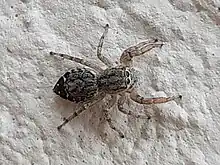| Pseudicius sengwaensis | |
|---|---|
 | |
| An example of the related species Pseudicius kulczynskii | |
| Scientific classification | |
| Domain: | Eukaryota |
| Kingdom: | Animalia |
| Phylum: | Arthropoda |
| Subphylum: | Chelicerata |
| Class: | Arachnida |
| Order: | Araneae |
| Infraorder: | Araneomorphae |
| Family: | Salticidae |
| Subfamily: | Salticinae |
| Genus: | Pseudicius |
| Species: | P. sengwaensis |
| Binomial name | |
| Pseudicius sengwaensis Wesołowska & Cumming, 2011 | |
Pseudicius sengwaensis is a species of jumping spider in the genus Pseudicius that lives in Zimbabwe. It is found in the Sengwa Wildlife Research Area, after which it is named. The spider was first described in 2011 by Wanda Wesołowska and Meg Cumming. The female has not been identified. The species is very similar to Afraflacilla venustula, including the pattern on the abdomen. It is a small spider, with a cephalothorax that is typically 1.8 mm (0.071 in) long and an abdomen typically 2.3 mm (0.091 in) long. It can be most easily distinguished from other members of the genus by its copulatory organs. The palpal bulb has a distinctive irregular shape, as is the embolus base.
Taxonomy
Pseudicius sengwaensis is a jumping spider that was first described by Wanda Wesołowska and Meg Cumming in 2011.[1] They allocated the species to the genus Pseudicius, first raised by Eugène Simon in 1885.[2] The genus name is related to two Greek words that can be translated false and honest.[3] The genus was provisionally placed alongside Icius that, despite looking superficially similar, has a different etymology.[4][5] The two genera were placed in the tribe Heliophaninae alongside Afraflacilla and Marchena.Maddison renamed the tribe Chrysillini in 2015.[6] The tribe is a member of the clade Saltafresia within the subfamily Salticoida.[7] A year later, in 2016, Jerzy Prószyński allocated the genus to the Pseudiciines group of genera, which was named after the genus.[8] Marchena is a member of the group, while Icius is not, as they are now defined as very different genera. They have flattened and elongated body and a characteristic colour pattern.[9] The species name derives from the name of the Sengwa Wildlife Research Area.[10]
Description
Pseudicius sengwaensis is a small spider with an elongated body typical of the genus. The male has a cephalothorax that is typically 1.8 mm (0.071 in) long and 1.2 mm (0.047 in) wide. It has a flat oval, dark brown carapace covered in delicate hairs. The eye field has brown bristles and white scales near the eyes. The chelicerae, labium and sternum are brownish. The elongated abdomen is typically 2.3 mm (0.091 in) long and 1.1 mm (0.043 in) wide. It is blackish with a pattern of eight white spots in pairs, similar to Afraflacilla venustula. The underside is light and the spinnerets are brown. The legs are light brown apart from the first pair, which are darker. The front legs are also swollen and thicker. The pedipalps has two tibial apophyses, one longer than the other. The palpal bulb is irregular in shape and a long thin embolus.[10] The species differs from others in the genus in the shape of palpal bulb and the position of its embolus base.[11] The female has not been described.[1]
Distribution and habitat
Pseudicius spiders can be found across Afro-Eurasia and the Eastern hemisphere.[12] Pseudicius sengwaensis is endemic to Zimbabwe.[1] The holotype was found in the Sengwa Wildlife Research Area during 2002. The species is tree-dwelling. It has particularly been found living in Vachellia tortilis.[11]
References
Citations
- 1 2 3 World Spider Catalog (2017). "Pseudicius sengwaensis Wesołowska & Cumming, 2011". World Spider Catalog. 18.0. Bern: Natural History Museum. Retrieved 2 April 2017.
- ↑ Wesołowska & Haddad 2013, p. 213.
- ↑ Fernández-Rubio 2013, p. 129.
- ↑ Fernández-Rubio 2013, p. 127.
- ↑ Maddison, Bodner & Needham 2008, p. 56.
- ↑ Maddison 2015, pp. 247, 252.
- ↑ Maddison 2015, p. 278.
- ↑ Prószyński 2017, p. 36.
- ↑ Prószyński 2017, p. 42.
- 1 2 Wesołowska & Cumming 2011, p. 96.
- 1 2 Wesołowska & Cumming 2011, p. 93.
- ↑ Haddad & Wesołowska 2011, p. 109.
Bibliography
- Fernández-Rubio, Fidel (2013). "La etimología de los nombres de las arañas (Araneae)" [The etymology of the names of spiders (Araneae)]. Revista ibérica de Aracnología (in Spanish) (22): 125–130. ISSN 1576-9518.
- Haddad, Charles R.; Wesołowska, Wanda (2011). "New species and new records of jumping spiders (Araneae: Salticidae) from central South Africa". African Invertebrates. 52 (1): 51–134. doi:10.5733/afin.052.0105. S2CID 86586010.
- Maddison, Wayne P. (2015). "A phylogenetic classification of jumping spiders (Araneae: Salticidae)". The Journal of Arachnology. 43 (3): 231–292. doi:10.1636/arac-43-03-231-292. S2CID 85680279.
- Maddison, Wayne P.; Bodner, Melissa R.; Needham, Karen M. (2008). "Salticid spider phylogeny revisited, with the discovery of a large Australasian clade (Araneae: Salticidae)". Zootaxa. 1893: 49–64. doi:10.11646/zootaxa.1893.1.3.
- Prószyński, Jerzy (2017). "Pragmatic classification of the World's Salticidae (Araneae)". Ecologica Montenegrina. 12: 1–133. doi:10.37828/em.2017.12.1.
- Richman, David B.; Jackson, Robert R. (1992). "A review of the ethology of jumping spiders (Araneae, Salticidae)". Bulletin of the British Arachnology Society. 9 (2): 33–37.
- Wesołowska, Wanda; Cumming, Meg S. (2011). "New species and records of jumping spiders (Araneae, Salticidae) from Sengwa Wildlife Research Area in Zimbabwe". Journal of Afrotropical Zoology. 7 (1): 75–104.
- Wesołowska, Wanda; Haddad, Charles R. (2013). "New Data on the Jumping Spiders of South Africa (Araneae: Salticidae)". African Invertebrates. 54 (1): 177–240. doi:10.5733/afin.054.0111.